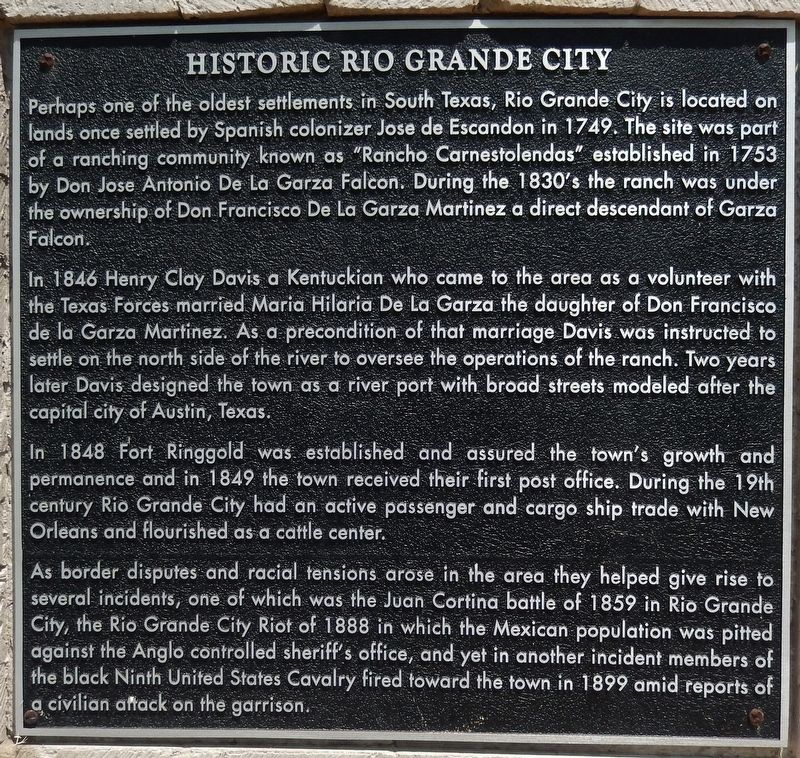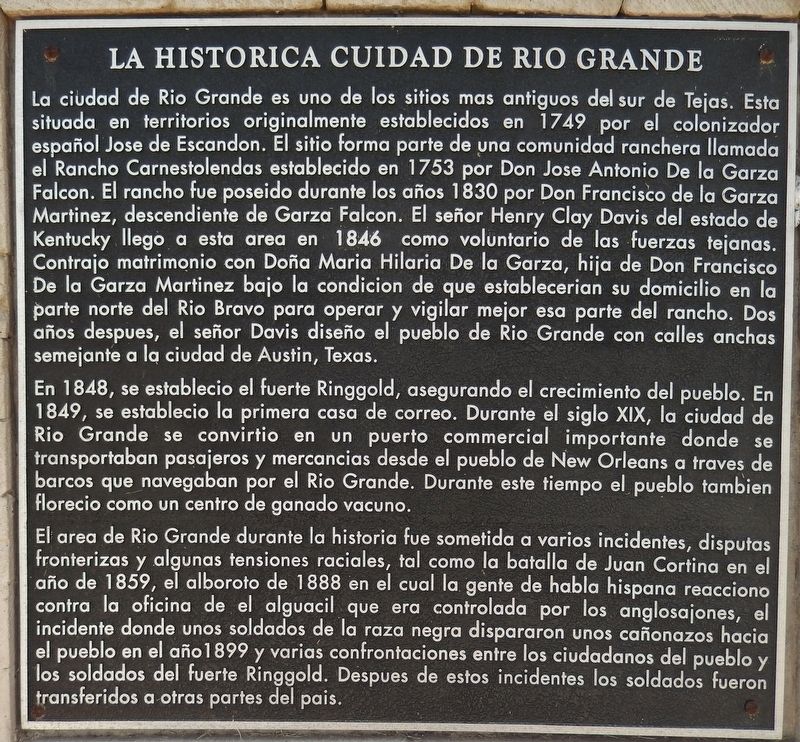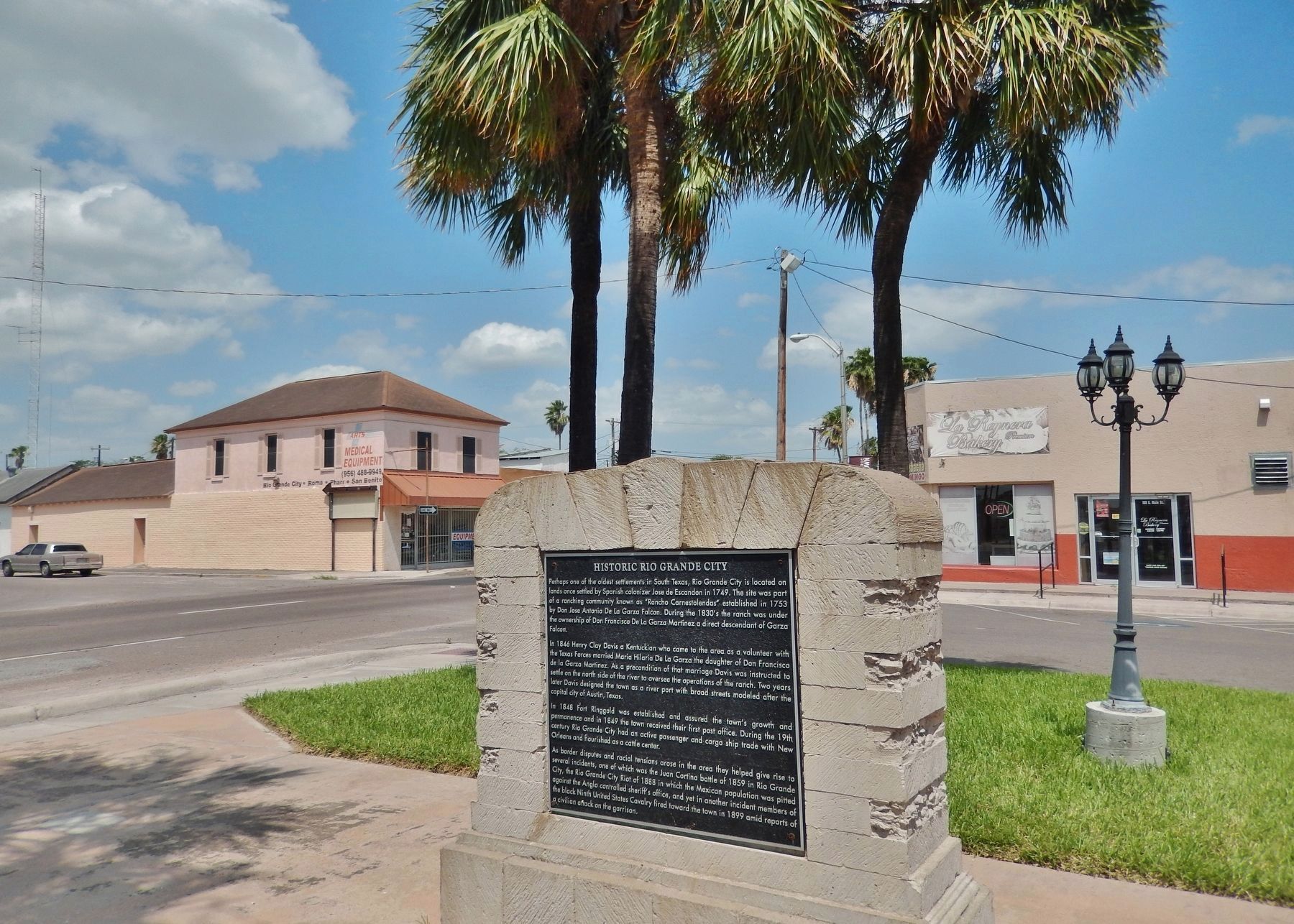Rio Grande City in Starr County, Texas — The American South (West South Central)
Historic Rio Grande City
(side one – English)
Perhaps one of the oldest settlements in South Texas, Rio Grande City is located on lands once settled by Spanish colonizer José de Escandón in 1749. The site was part of a ranching community known as "Rancho Carnestolendas" established in 1753 by Don Jose Antonio De La Garza Falcon. During the 1830's the ranch was under the ownerships of Don Francisco De La Garza Martinez a direct descendant of Garza Falcon.
In 1846 Henry Clay Davis a Kentuckian who came to the area as a volunteer with the Texas Forces married Maria Hilaria De La Garza the daughter of Don Francisco de la Garza Martinez. As a precondition of that marriage Davis was instructed to settle on the north side of the river to oversee the operations of the ranch. Two years later Davis designed the town as a river port with broad streets modeled after the capital city of Austin, Texas.
In 1848 Fort Ringgold was established and assured the town’s growth and permanence and in 1849 the town received their first post office. During the 19th century Rio Grande City had an active passenger and cargo ship trade with New Orleans and flourished as a cattle center.
As border disputes and racial tensions arose in the area they helped give rise to several incidents, one of which was the Juan Cortina battle of 1859 in Rio Grande City, the Rio Grande City Riot of 1888 in which the Mexican population was pitted against the Anglo controlled sheriff’s office, and yet in another incident members of the black Ninth United States Cavalry fired toward the town in 1899 amid reports of a civilian attack on the garrison.
(side two – Spanish)
La ciudad de Rio Grande es uno de los sitios mas antiguos del sur de Tejas. Esta situada en territorios originalmente establecidos en 1749 por el colonizador español Jose de Escandon. El sitio forma parte de una comunidad ranchera llamada el Rancho Carnestolendas establecido en 1753 por Don Jose Antonio De la Garza Falcon. El rancho fue poseido durante los años 1830 por Don Francisco de la Garza Martinez, descendiente de Garza Falcon. El señor Henry Clay Davis del estado de Kentucky llego a esta area en 1846 como voluntario de las fuerzas tejanas. Contrajo matrimonio con Doña Maria Hilaria De la Garza, hija de Don Francisco De la Garza Martinez bajo la condicion de que establecerian su domicilio en la parte norte del Rio Bravo para operar y vigilar mejor esa parte del rancho. Dos años despues, el señor Davis diseño el pueblo de Rio Grande con calles anchas semejante a la ciudad de Austin, Texas.
En 1848, se establecio el fuerte Ringgold, asegurando el crecimiento del pueblo. En 1849, se establecio la primera
casa de correo. Durante el siglo XIX, la ciudad de Rio Grande se convirtio en un puerto commercial importante donde se transportaban pasajeros y mercancias desde el pueblo de New Orleans a traves de barcos que navegaban por el Rio Grande. Durante este tiempo el pueblo tamliien florecio como un centro de ganado vacuno.
El area de Rio Grande durante la historia fue sometida a varios incidentes, disputas fronterizas y algunas tensiones raciales, tal como la batalla de Juan Cortina en el año de 1859, el alboroto de 1888 en el cual la gente de habla hispana reacciono contra la oficina de el alguacil que era controlada por los anglosajones, el incidente donde unos soldados de la raza negra dispararon unos cañonazos hacia el pueblo en el año 1899 y varias confrontaciones entre los ciudadanos del pueblo y los soldados del fuerte Ringgold. Despues de estos incidentes los soldados fueron transferidos a otras partes del pais.
Topics. This historical marker is listed in these topic lists: Hispanic Americans • Industry & Commerce • Settlements & Settlers. A significant historical year for this entry is 1749.
Location. 26° 22.736′ N, 98° 49.243′ W. Marker is in Rio Grande City, Texas, in Starr County. Marker is at the intersection of 1st Street (Main Street) (Business U.S. 83) and Britton Avenue, on the right when traveling east
on 1st Street (Main Street). Marker is located at the north end of the plaza, at this intersection. Touch for map. Marker is in this post office area: Rio Grande City TX 78582, United States of America. Touch for directions.
Other nearby markers. At least 8 other markers are within walking distance of this marker. Site of Old Rancho Davis (within shouting distance of this marker); Site of Cortina Battle (within shouting distance of this marker); Rio Grande City, C.S.A (within shouting distance of this marker); Starr County (about 300 feet away, measured in a direct line); Mifflin Kenedy Warehouse (about 500 feet away); Immaculate Conception School (about 700 feet away); Gregorio Barrera (about 800 feet away); José de Escandón (approx. 0.2 miles away). Touch for a list and map of all markers in Rio Grande City.
Also see . . .
1. Rio Grande City. Rio Grande City, the county seat of Starr County and one of the oldest settlements in South Texas, is on the Rio Grande 100 miles from both Brownsville and Laredo in the extreme south central part of the county. It is an international port of entry connected by bridge to Camargo, Tamaulipas. (Submitted on June 30, 2018, by Cosmos Mariner of Cape Canaveral, Florida.)
2. Henry Clay Davis. Henry Clay Davis (known to friends as Clay), soldier, merchant, landowner, state senator, Texas Ranger, and founder of Starr County seat Rio Grande City, was born in Georgia in 1814. Davis was active in the military during the years of the Republic of Texas and participated in a number of engagements against Indian groups as well as defense against Mexican incursions. In the days before the outbreak of the Civil War, Davis, like many in his position on the border, favored the Union but was Texan first and decided that he would support the decision for Texas to join the Confederacy. Davis, though against the war, prospered from the wartime cotton trade along the river. (Submitted on June 30, 2018, by Cosmos Mariner of Cape Canaveral, Florida.)
3. Juan Nepomuceno Cortina. In the decade following the Treaty of Guadalupe Hidalgo, Cortina came to hate a clique of judges and Brownsville attorneys whom he accused of expropriating land from Mexican Texans unfamiliar with the American judicial system. He became a leader to many of the poorer Mexicans who lived along the banks of the river. The incident that ignited the first so-called Cortina War occurred on July 13, 1859, when Cortina saw the Brownsville city marshal, Robert Shears, brutally arrest a Mexican American who had once been employed by Cortina. Cortina shot the marshal in the impending confrontation and rode out of town with the prisoner. Early on the morning of September 28, 1859, he rode into Brownsville again, this time at the head of some forty to eighty men, and seized control of the town. (Submitted on June 30, 2018, by Cosmos Mariner of Cape Canaveral, Florida.)
4. Rio Grande City Riot of 1888. The riot was set off by the arrest in May of Abraham Recéndez, a Mexican-American resident of Rio Grande City. He was arrested for robbery by Starr county sheriff W. W. Sheley and after the arrest was killed by Victor Sebree, United States Inspector of Customs and Sheley's companion, while allegedly attempting to escape. The incident led to public anger, particularly against Sheley, who previously had been implicated in the lynching of several Mexicans. (Submitted on June 30, 2018, by Cosmos Mariner of Cape Canaveral, Florida.)
Credits. This page was last revised on July 4, 2018. It was originally submitted on June 30, 2018, by Cosmos Mariner of Cape Canaveral, Florida. This page has been viewed 1,106 times since then and 294 times this year. Photos: 1, 2, 3. submitted on June 30, 2018, by Cosmos Mariner of Cape Canaveral, Florida. • Andrew Ruppenstein was the editor who published this page.


